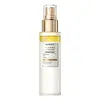What's inside
What's inside
 Key Ingredients
Key Ingredients

 Benefits
Benefits

 Concerns
Concerns

 Ingredients Side-by-side
Ingredients Side-by-side

Bifida Ferment Filtrate
Skin ConditioningLactobacillus Ferment
Skin ConditioningIsododecane
EmollientButylene Glycol
HumectantDiphenylsiloxy Phenyl Trimethicone
Skin ConditioningGlycerin
HumectantSqualane
EmollientPEG/PPG/Polybutylene Glycol-8/5/3 Glycerin
HumectantNiacinamide
SmoothingCentella Asiatica Leaf Extract
Skin ConditioningOlea Europaea Leaf Extract
PerfumingPolyglycerin-10
HumectantWater
Skin Conditioning1,2-Hexanediol
Skin ConditioningThermus Thermophillus Ferment
Skin ConditioningEctoin
Skin ConditioningPanthenol
Skin ConditioningHydroxyacetophenone
AntioxidantSodium Chloride
MaskingSodium Hyaluronate
HumectantHippophae Rhamnoides Fruit Oil
Skin ProtectingAroma
Hexylene Glycol
EmulsifyingSaccharide Isomerate
HumectantCaprylhydroxamic Acid
Citric Acid
BufferingSodium Citrate
BufferingBifida Ferment Filtrate, Lactobacillus Ferment, Isododecane, Butylene Glycol, Diphenylsiloxy Phenyl Trimethicone, Glycerin, Squalane, PEG/PPG/Polybutylene Glycol-8/5/3 Glycerin, Niacinamide, Centella Asiatica Leaf Extract, Olea Europaea Leaf Extract, Polyglycerin-10, Water, 1,2-Hexanediol, Thermus Thermophillus Ferment, Ectoin, Panthenol, Hydroxyacetophenone, Sodium Chloride, Sodium Hyaluronate, Hippophae Rhamnoides Fruit Oil, Aroma, Hexylene Glycol, Saccharide Isomerate, Caprylhydroxamic Acid, Citric Acid, Sodium Citrate
Water
Skin ConditioningGlycerin
HumectantPropanediol
SolventBetaine
HumectantPhenoxyethanol
PreservativeHydroxyethyl Urea
HumectantHydroxyacetophenone
AntioxidantPEG-40 Hydrogenated Castor Oil
EmulsifyingDisodium EDTA
Dipotassium Glycyrrhizate
HumectantAloe Barbadensis Leaf Juice
Skin ConditioningParfum
MaskingButylene Glycol
HumectantPortulaca Oleracea Extract
Skin ConditioningPanthenol
Skin Conditioning1,2-Hexanediol
Skin ConditioningTrehalose
HumectantCentella Asiatica Extract
CleansingPentylene Glycol
Skin ConditioningSodium Acetylated Hyaluronate
HumectantEthylhexylglycerin
Skin ConditioningSodium Hyaluronate
HumectantSodium Hyaluronate Crosspolymer
HumectantHydrolyzed Sodium Hyaluronate
Skin ConditioningWater, Glycerin, Propanediol, Betaine, Phenoxyethanol, Hydroxyethyl Urea, Hydroxyacetophenone, PEG-40 Hydrogenated Castor Oil, Disodium EDTA, Dipotassium Glycyrrhizate, Aloe Barbadensis Leaf Juice, Parfum, Butylene Glycol, Portulaca Oleracea Extract, Panthenol, 1,2-Hexanediol, Trehalose, Centella Asiatica Extract, Pentylene Glycol, Sodium Acetylated Hyaluronate, Ethylhexylglycerin, Sodium Hyaluronate, Sodium Hyaluronate Crosspolymer, Hydrolyzed Sodium Hyaluronate
Ingredients Explained
These ingredients are found in both products.
Ingredients higher up in an ingredient list are typically present in a larger amount.
1,2-Hexanediol is a synthetic liquid and another multi-functional powerhouse.
It is a:
- Humectant, drawing moisture into the skin
- Emollient, helping to soften skin
- Solvent, dispersing and stabilizing formulas
- Preservative booster, enhancing the antimicrobial activity of other preservatives
Butylene Glycol (or BG) is used within cosmetic products for a few different reasons:
Overall, Butylene Glycol is a safe and well-rounded ingredient that works well with other ingredients.
Though this ingredient works well with most skin types, some people with sensitive skin may experience a reaction such as allergic rashes, closed comedones, or itchiness.
Learn more about Butylene GlycolGlycerin is already naturally found in your skin. It helps moisturize and protect your skin.
A study from 2016 found glycerin to be more effective as a humectant than AHAs and hyaluronic acid.
As a humectant, it helps the skin stay hydrated by pulling moisture to your skin. The low molecular weight of glycerin allows it to pull moisture into the deeper layers of your skin.
Hydrated skin improves your skin barrier; Your skin barrier helps protect against irritants and bacteria.
Glycerin has also been found to have antimicrobial and antiviral properties. Due to these properties, glycerin is often used in wound and burn treatments.
In cosmetics, glycerin is usually derived from plants such as soybean or palm. However, it can also be sourced from animals, such as tallow or animal fat.
This ingredient is organic, colorless, odorless, and non-toxic.
Glycerin is the name for this ingredient in American English. British English uses Glycerol/Glycerine.
Learn more about GlycerinHydroxyacetophenone is antioxidant with skin conditioning and soothing properties. It also boosts the efficiency of preservatives.
This ingredient is not irritating or sensitizing.
Panthenol is a common ingredient that helps hydrate and soothe the skin. It is found naturally in our skin and hair.
There are two forms of panthenol: D and L.
D-panthenol is also known as dexpanthenol. Most cosmetics use dexpanthenol or a mixture of D and L-panthenol.
Panthenol is famous due to its ability to go deeper into the skin's layers. Using this ingredient has numerous pros (and no cons):
Like hyaluronic acid, panthenol is a humectant. Humectants are able to bind and hold large amounts of water to keep skin hydrated.
This ingredient works well for wound healing. It works by increasing tissue in the wound and helps close open wounds.
Once oxidized, panthenol converts to pantothenic acid. Panthothenic acid is found in all living cells.
This ingredient is also referred to as pro-vitamin B5.
Learn more about PanthenolSodium Hyaluronate is hyaluronic acid's salt form. It is commonly derived from the sodium salt of hyaluronic acid.
Like hyaluronic acid, it is great at holding water and acts as a humectant. This makes it a great skin hydrating ingredient.
Sodium Hyaluronate is naturally occurring in our bodies and is mostly found in eye fluid and joints.
These are some other common types of Hyaluronic Acid:
Learn more about Sodium HyaluronateWater. It's the most common cosmetic ingredient of all. You'll usually see it at the top of ingredient lists, meaning that it makes up the largest part of the product.
So why is it so popular? Water most often acts as a solvent - this means that it helps dissolve other ingredients into the formulation.
You'll also recognize water as that liquid we all need to stay alive. If you see this, drink a glass of water. Stay hydrated!
Learn more about Water